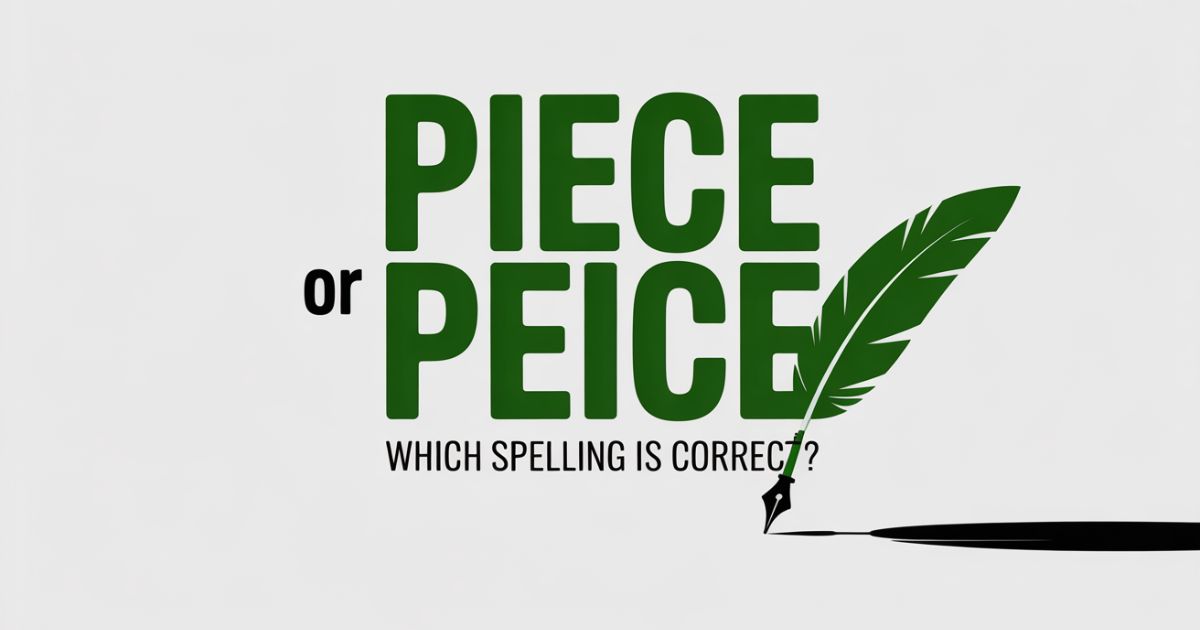In the English language, spelling can often feel like a puzzle. One of the more common errors made by writers students and professionals alike is confusing the spelling of “piece” with “peice.” While it might seem like a small mistake, choosing the correct spelling is important if you want to come across as polished and credible.
So, let’s set the record straight: “Piece” is the correct spelling.
“Peice” is a common misspelling.
Let’s explore why this confusion happens, some easy ways to remember the correct spelling, and where you’ll most likely encounter this word in real-life situations.
Why Do People Confuse “Piece” and “Peice”?
At first glance, both “piece” and “peice” seem plausible. They’re only one letter apart, and both follow similar spelling patterns to other English words. The confusion usually stems from the rule “i before e except after c,” which is not always reliable.
Let’s break it down.
According to the rule, you might think that “peice” makes sense because the “i” comes before the “e.” However, the correct spelling, “piece,” breaks that rule just like other common exceptions such as “weird,” “seize,” and “height.”
This inconsistency is exactly why spelling can trip people up. English borrows from many other languages, and that makes it unpredictable at times.
The Correct Spelling: Piece
“Piece” is the correct spelling of the word. It’s a noun most of the time, and it can also function as a verb.
Common Meanings of “Piece”:
- A portion or part of something
Example: “Can I have a piece of cake?” - A unit of something, often used in art or writing
Example: “She wrote an interesting piece on climate change.” - A musical or theatrical work
Example: “They performed a classical piece by Mozart.” - A component of a whole
Example: “Each piece of the puzzle fits perfectly.”
As a verb:
When used as a verb, “piece” usually means to assemble or put together something.
Example: “He managed to piece together the torn photograph.”
Scenarios Where You Might Use “Piece”
Understanding how to use “piece” in context is key. Let’s look at a few everyday scenarios to drive the meaning home.
1. In the Kitchen
Imagine you’ve just baked a chocolate cake. Your friend walks in and says:
“That smells amazing! Can I have a piece?”
Here, “piece” refers to a portion of the whole cake.
2. At Work
Your boss compliments you on a report you submitted:
“Great piece on the customer feedback data. Very insightful!”
In this scenario, “piece” means a written report or article.
3. At the Museum
You’re on a tour, and the guide stops to show you a sculpture:
“This piece was created in the 18th century by a French artist.”
Now, “piece” means a work of art.
4. In Problem Solving
A detective is investigating a case:
“We’re starting to piece together what happened that night.”
Used as a verb here, “piece” means to reconstruct or understand something by putting information together.
What About “Peice”? Why Is It Incorrect?
“Peice” is not a real word. If you try typing it in most word processors, it will be underlined in red. That’s your software’s way of saying: “Hey, check your spelling!”
Despite not being correct, many people still type “peice” because:
- The “i before e” rule is misleading
- It sounds similar to how “piece” is pronounced
- They’re typing too fast or not proofreading
It’s a small but noticeable mistake—especially in professional or academic writing.
How to Remember the Correct Spelling: “Piece”
If you often find yourself mixing up “piece” and “peice,” you’re not alone. Here are a few mnemonics and tricks to help you remember:
🎯 “A piece of pie”
Think of “piece” as a “piece of pie.” Both “piece” and “pie” start with “pi.”
Easy to visualize, and even easier to remember.
🧩 “Each puzzle has its piece.”
Associate the word “piece” with something that fits or completes a whole—like a puzzle.
📜 Remember this sentence:
“Piece has a C like in cake, and you always want a piece of cake.”
Silly? Maybe. But it works!
Other Commonly Confused Words Like “Piece”
The English language has many homophones—words that sound alike but are spelled differently and have different meanings. “Piece” is one of them. Let’s look at a few others:
| Word | Confused With | Meaning |
|---|---|---|
| Piece | Peace | “Piece” means a portion; “Peace” means tranquility |
| Their | There / They’re | Possessive vs. location vs. contraction |
| Your | You’re | Possessive vs. contraction of “you are” |
| Here | Hear | Place vs. the sense of hearing |
So, when you’re writing, always ask: Does this word mean what I think it means? Is it spelled correctly?
Quick Grammar Tip: Use “Piece” in Sentences to Practice
Here are a few practice sentences. Try saying them out loud or writing them down to reinforce correct usage:
- “I just want one piece of chocolate, not the whole bar.”
- “Her latest piece in the magazine got a lot of attention.”
- “Can you help me piece together the events from last night?”
- “This sculpture is a stunning piece of modern art.”
- “He forgot a piece of his uniform at home.”
Notice how natural the word feels in all of these examples? That’s because it’s the right choice.
Final Thoughts
To sum it up:
- “Piece” is the correct spelling.
- “Peice” is a misspelling.
- You can remember it with simple tricks like “a piece of pie.”
- Context matters piece can mean part of something, an article, a work of art, or be used as a verb.
It’s easy to make mistakes with spelling in English, but the good news is: with a little practice, it becomes second nature. So next time you’re writing and pause at “piece” or “peice,” you’ll know exactly which one is right.


